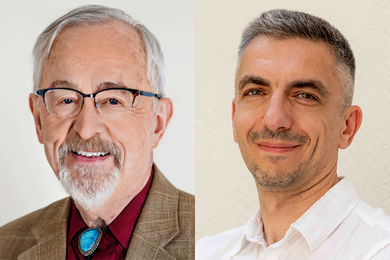MIT graduate student Samuel C. Crawford, working in Associate Professor Silvija Gradečak’s Laboratory for Nanophotonics and Electronics, is lending a new understanding to growing semiconducting nanowires for solar cells, LEDs and other uses.
Crawford’s research demonstrated control of the composition and diameter along individual nanowires composed of indium gallium nitride (InGaN) by varying the flow of gaseous precursors containing the desired materials, such as gallium, through a quartz chamber containing substrates coated with gold seed particles. “Essentially what we’re doing is changing the flows of our III and V precursors (elements from columns III and V of the periodic table) during growth in order to change the composition and morphology of the nanowires,” Crawford says. Crawford and colleagues grew nanowires with a “caterpillar” shape by alternating indium nitride and indium gallium nitride layers within the nanowire, leading to changes in diameter.
Crawford, a National Science Foundation graduate research fellow, first reported the nanowire synthesis results in a paper with Gradečak, Sung Keun Lim PhD ’11 and Geog Haberfelner of CEA-LETI in France, then in a subsequent paper provided a theoretical understanding of principles generally applicable to nanowire growth.
The seed particle
In Gradečak’s chemical vapor deposition system, nanowires are grown at temperatures from 500 to 1,000 degrees Centrigade by the “vapor-liquid-solid” mechanism in which elements from gaseous precursors alloy with a liquid seed particle and react with one another to form a solid nanowire. The seed metal helps to mediate nanowire growth but does not participate in the reaction.
Scanning transmission electron microscopy coupled with energy dispersive X-ray spectroscopy allowed Crawford to calculate the percentages of the precursor atoms in the seed particle alloy, which confirmed that the changes in nanowire diameter resulted from changes in seed particle volume and composition. “X-rays can be emitted as a result of knocking electrons out of an atom, and so the energy of the produced X-ray depends on the atom that you’re probing, so the X-rays provide a fingerprint of the atoms in your material,” Crawford says. In collaboration with CEA-LETI, electron tomography also revealed the geometric shape, or morphology, of the nanowires.
Read the full article
Crawford’s research demonstrated control of the composition and diameter along individual nanowires composed of indium gallium nitride (InGaN) by varying the flow of gaseous precursors containing the desired materials, such as gallium, through a quartz chamber containing substrates coated with gold seed particles. “Essentially what we’re doing is changing the flows of our III and V precursors (elements from columns III and V of the periodic table) during growth in order to change the composition and morphology of the nanowires,” Crawford says. Crawford and colleagues grew nanowires with a “caterpillar” shape by alternating indium nitride and indium gallium nitride layers within the nanowire, leading to changes in diameter.
Crawford, a National Science Foundation graduate research fellow, first reported the nanowire synthesis results in a paper with Gradečak, Sung Keun Lim PhD ’11 and Geog Haberfelner of CEA-LETI in France, then in a subsequent paper provided a theoretical understanding of principles generally applicable to nanowire growth.
The seed particle
In Gradečak’s chemical vapor deposition system, nanowires are grown at temperatures from 500 to 1,000 degrees Centrigade by the “vapor-liquid-solid” mechanism in which elements from gaseous precursors alloy with a liquid seed particle and react with one another to form a solid nanowire. The seed metal helps to mediate nanowire growth but does not participate in the reaction.
Scanning transmission electron microscopy coupled with energy dispersive X-ray spectroscopy allowed Crawford to calculate the percentages of the precursor atoms in the seed particle alloy, which confirmed that the changes in nanowire diameter resulted from changes in seed particle volume and composition. “X-rays can be emitted as a result of knocking electrons out of an atom, and so the energy of the produced X-ray depends on the atom that you’re probing, so the X-rays provide a fingerprint of the atoms in your material,” Crawford says. In collaboration with CEA-LETI, electron tomography also revealed the geometric shape, or morphology, of the nanowires.
Read the full article







